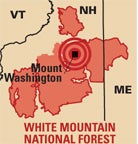Heading out the door? Read this article on the new Outside+ app available now on iOS devices for members! Download the app.
The Hike
Known as the most dangerous small mountain in the world, 6,288-foot Mt. Washington boasts some scary stats: The highest wind velocity ever recorded at any surface weather station (231 mph) was logged here on April 12, 1934. And almost 150 fatalities have occurred since 1849. No surprise: Most are due to hypothermia–and not only in winter. “They call them the White Mountains for a reason,” says Lieutenant Todd Bogardus, SAR team leader for New Hampshire’s Fish & Game Department. “We see snow right on through the year.” Several weather patterns collide on Washington and produce its notoriously foul weather, which can move in quickly. In 60-mph winds, hiking becomes nearly impossible: Traveling north along the Crawford Ridge from Washington’s summit, hikers routinely–and unknowingly–get blown off course by powerful westerly winds, which shove them down off the ridge into the Great Gulf or the Dry River Valley. “It’s human nature to go with the wind rather than into it,” says Bogardus. Unfortunately, hikers often find the winds have steered them many miles from trails and roads, thwarting their safe return.
Exhibit A
Staff at the Pinkham Notch Visitor Center warned 23-year-old Gabriel Gauthier that 1 p.m. was too late to start a summit bid. But sunny, 70°F weather in the valley convinced him otherwise, and on September 21, 2006, he and three friends hiked up the peak in little more than shorts and T-shirts. The mercury plummeted 40 degrees as they climbed, and Gauthier’s body temperature dropped as well, ultimately rendering him unconscious. His pals continued to the summit and summoned help by breaking into buildings that had been closed for the season, but rescuers couldn’t revive Gauthier. He lives–but with massive brain damage inflicted by profound hypothermia.

Survival Plan
Lots of New England’s nor’easters are predicted well in advance, so check the Mt. Washington Observatory forecast (mountwashington.org/weather). And most accidents occur in shoulder seasons to hikers not expecting winter to last so long or summer to end so quickly. Plan for high winds and icy temps, and pack warm, weatherproof layers and an emergency blanket or bivy sack. Check hikesafe.com for more tips on surviving Washington.
